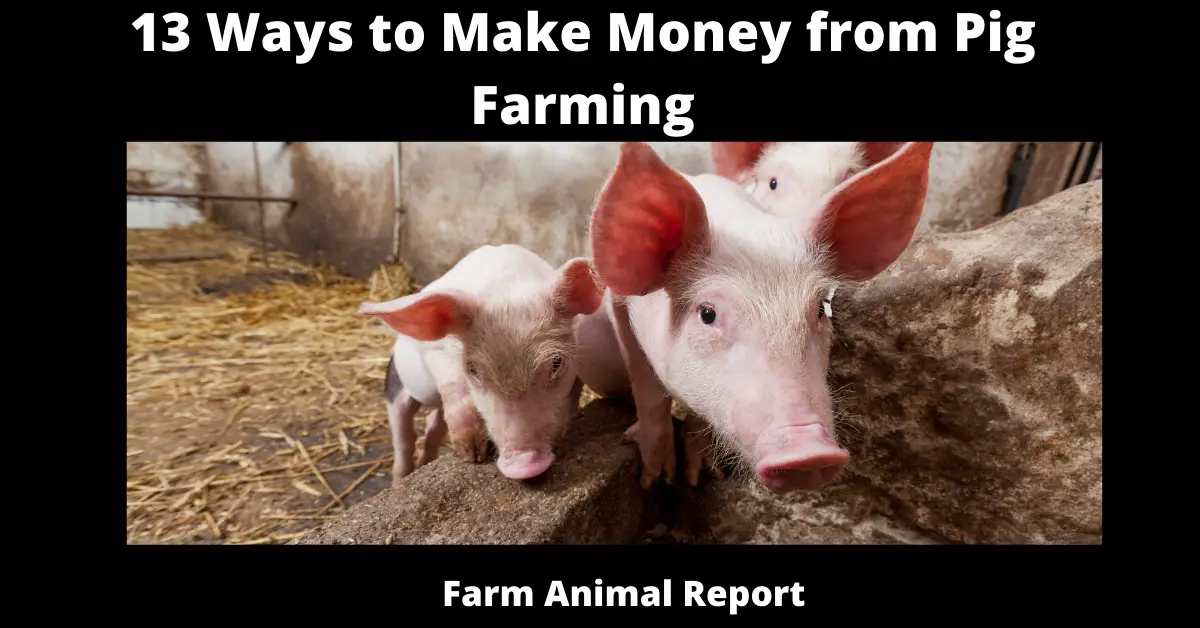As a General Rule Pig farming or hog farming is the raising and breeding of domestic pigs as livestock and is a branch of animal husbandry. Pigs are farmed principally 3 ways 1) Farrow-to-finish 2) Farrow-to-feeder 3) Feeder-to-finish. If you farm one pig in the United States, you can expect to make a net profit of between $100 and $500 after half a year of farming
- Farrow to Finish
- Farrow to Feeder
- Feeder to finish
- Free Range Pigs
- Pork Bellies
- Fresh Hams
- Fresh Loin
- Pork Ribs
- Pork Chops
- Pig manuere
- Transporting Stock
- Custom Feeds
- Stud Fees
Ways to Make Money Pig Farming
Ways to make money from pig farming – You may have enjoyed raising pigs as pets, but you may not have realized that you can also make a tremendous amount of money from it. Many people aware of this gold mine are undoubtedly asking themselves the same question: how many pigs will be required to generate a profit from the venture.
In as much as this question appears to be impossible to answer, the good news is that developing money from learning to raise pigs, rearing is not dependent on the number of sows (female pigs) you have; instead, it is dependent on how well you manage the ones you do have, as well as the number of piglets they produce.
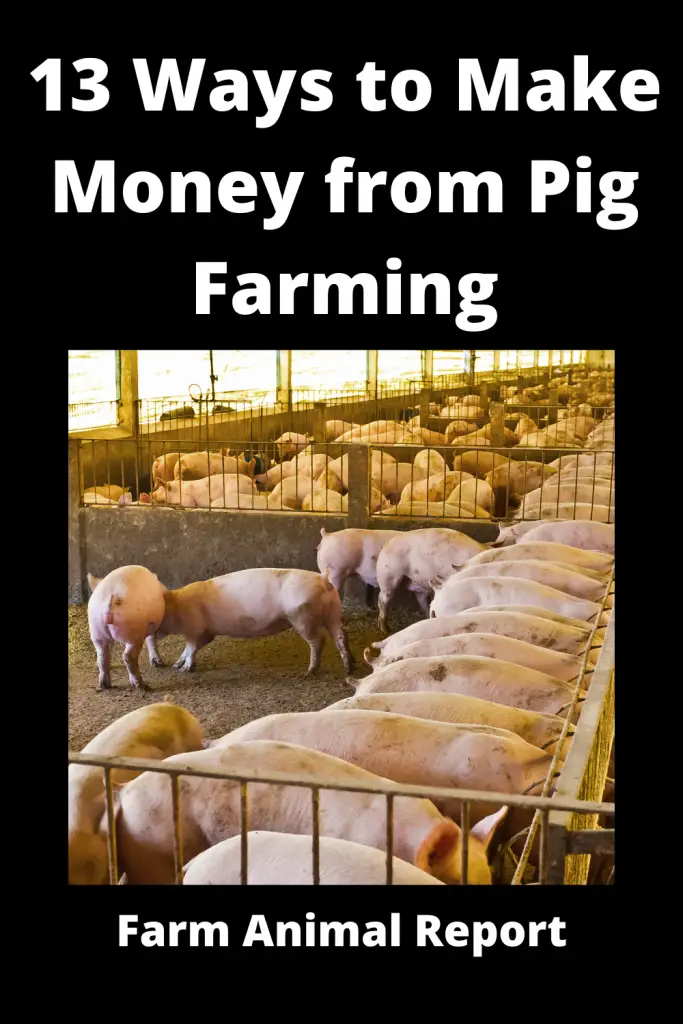
Ways to Make Money from Swine Farming
- The first step is to sell the meat of the pig. Pig meat (also known as pork) is a staple diet for everyone, and it is highly nutritious meat with a high fat to water ratio. It is also a valuable by-product with high market demand from all over the world. Investing in plumping pigs for meat production also entails feeding them only pesticide-free and professionally produced foods while raising them for meat production. Because pigs are not picky eaters when it comes to food, any leftovers from your kitchen can be fed to them to supplement their diet. The feed conversion efficiency of pigs is second only to that of boilers, and they generate significantly more Meat from a given amount of feed when compared to other species. One full-grown pig weighing approximately 70 kg can sell for up to $300.
- The second option is to produce fertilizers. Pig dung can be used to create a substantial amount of money. As a pig farmer, you can collect manure and convert it into high-quality fertilizer components. It is becoming increasingly important to use pigs as a source of fat. The demand for it is increasing rapidly in the soap and paint manufacturing industries and poultry feed and chemical industries. The hay that was used to line up your pen can be gathered, allowed to sit for about a week, and then sold to another farmer or, more likely, a well-known fertilizer corporation.
- Third, consider switching to organic farming. These animals are well-cared for, fed the best feed available, and subjected to the most stringent animal welfare standards available in the industry. When it comes to their health, people are more concerned about the food quality and Meat quality. Organic pig meat will allow your clients and prospective consumers to enjoy pig meat while having a far less negative impact on their health. When you become known for using solely organic feeds, you will attract more prospective clients due to your decision to go organic.
- A complete set of varied pig breeds can be obtained via auctions if you know how to properly pair the pig when you have a mixed group of mixed pig breeds. Perhaps you’ll be able to sell them off at a farm fair or an annual auction in your community.
3 Types of Pig Farms
There are three types of Pig farms:
- Farrow- to-finish
- Farrow-to-feeder
- Feeder-to-finish
The most crucial component of selecting the ideal production system for you is to design a production system that will match your resources and lifestyle, which is the most challenging component to determine.
You must first analyze the following factors to identify which farming type will perform best in your situation:
- The amount of capital, labor, and land that is readily available.
- Required level of management and marketing proficiency.
- The social and environmental consequences of manure management are well documented.
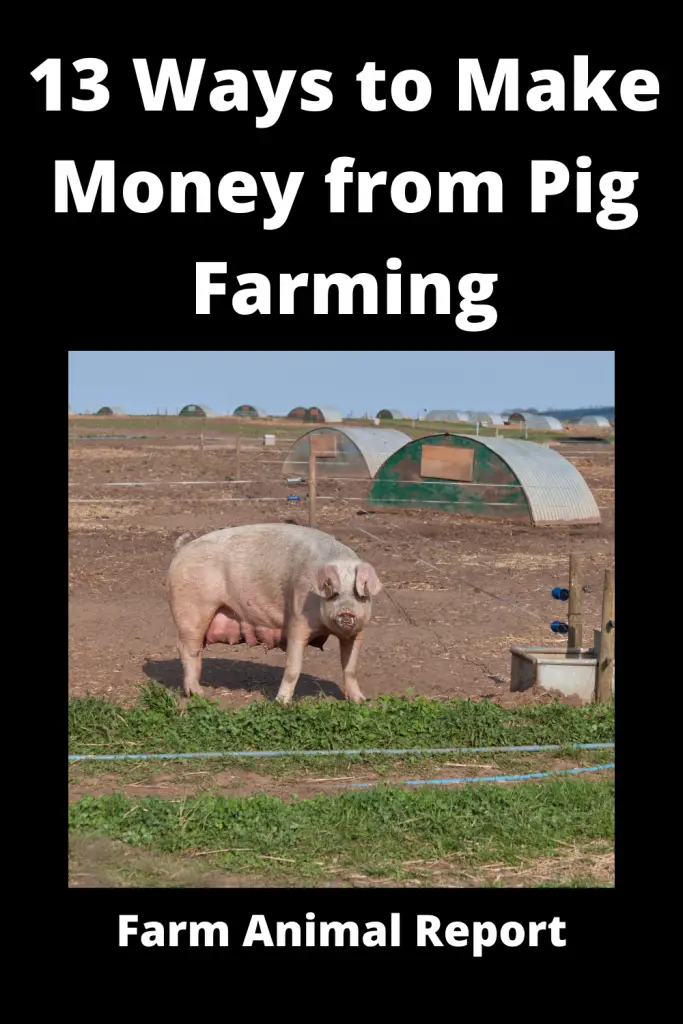
1. Farrow-to-Finish
A farrow-to-finish operation includes breeding and farrowing sows and feeding and caring for the progeny until they reach a market weight of approximately 280 lbs. This takes around ten months in total, with four months spent on breeding and gestation and six months spent raising the litter to market weight.
The complete production phase lasts approximately ten months. Farrow-to-finish is the approach with the highest long-term market potential and flexibility among the three options. This approach also necessitates the most significant investment in capital and labor and a long-term commitment to the swine industry. When farrowing are arranged to avoid peak harvest times, a limited number of sows can be accommodated in a crop operation with relative ease.
Most contemporary farrow-to-finish facilities are intended to house gestating sows in pens rather than crates, reflecting the current emphasis on animal welfare. However, this may increase the capital required for sow housing.
2. Farrow-to-Feeder
An enterprise that involves breeding and farrowing sows and then selling the piglets to finishing operations when they weigh between 30 and 60 pounds is known as a farrow-to-feeder firm. The demand for buildings, operating capital, and the amount of feed and manure handled are reduced compared to a farrow-to-finish operation when using this option.
It also serves as an outstanding basis for extending the number of sows in the herd or transitioning to a farrow-to-finish process. The most significant disadvantage of this system is that producers, particularly those with small packs, are at the mercy of a pig market, which is difficult to predict. During seasons of solid demand, this may necessitate the grouping of farrowing sows to increase the number of pigs available.
3. Feeder-to-Finish
The majority of feeder-to-finish operations purchase feeder pigs weighing 30 to 60 pounds and feed them until they reach market weight. In many circumstances, the current infrastructure is sufficient for the operation of this system. This system has a low overhead, requires little labor, and requires no long-term commitment on the part of the user.
A grain farmer can use his or her own produced feed to complete pigs without worrying about managing breeding stock through a feeder-to-finish business. The operation may also be able to profit from the manure’s high fertilizer content. Among the most severe issues to be concerned about are the source, health, and quality of feeder pigs purchased. Ideally, all feeder pigs should be sourced from a single farm in order to minimize the risk of herd health issues in the future.
Can you make Money Raising Pigs ?
Yes, you can make money from pig farming if you conduct your business in the manners described above. Making a profit from pig rearing is a function of how well you understand the requirements of your sows, the role of nutrition, illness control, and the expectations of the market.
The production of pigs can be a good source of revenue when the pigs are well cared for and in good health, free of diseases that are detrimental not only to the pigs themselves but also to the human population who consumes their Meat. Nutrition is critical in pig rearing since it decides whether a business will be successful or unsuccessful.
A large part of the reason that pig farming is highly profitable is that they reproduce exceptionally quickly; one female pig (Sow) can give birth to as many as 8 to 18 piglets at a time, and sows can give birth twice in a year on average. This, on the other hand, means that one sow can produce between 16 and 36 piglets per year, and these piglets can grow up to a market size of approximately 150 lbs in six months and be sold for up to $300 per piglet.
Consider the following scenario: you have just five good sows to begin with, and each sow produces 20 piglets twice a year. Pigs are highly versatile animals that are pretty simple to raise on a farm. There is a significant demand for pig farming products right now, both in the domestic market and in the international or export markets as well. Some of the ways to gain money from pig farming include the following.
What is the Most Profitable way to Raise Swine?
Raising pigs can be done in a variety of profitable methods. However, everything is dependent on your financial situation. However, the most beneficial way is to purchase at least two pregnant female pigs, depending on your budget and presuming you already have a piece of land set aside for this purpose (sows). Depending on the current market conditions, the price of each sow should be around $300 per animal. This means that you will require approximately $600 to purchase the sows. You can profitable make money raising pigs.
Depending on the cost of transportation in your area, you will also need to set aside some funds for transportation and feed and any other incidental expenses that may arise. Because you already have two-month-old pregnant sows, with correct feeding and care, the sows will produce between 8 and 18 young piglets each sow, leaving your community of pigs with between 16 to 36 young piglets after a few months of being bred and raised. It will take around 6.5 to 7.5 months for young piglets to reach full maturity before they are ready to be placed on the market.
The ability to swiftly grow a pig to fulfill market specifications for size and leanness is a critical component of successful pig breeding. It is well-known that pigs can lay down bones and muscles during their early periods or months of life. It would help if you took advantage of this ability and not skimp on their feeding while also ensuring that they are adequately fed to meet the standard nutritional requirements of pig farming.
Pigs are omnivores, which means that they require a diversified diet to receive all of the nutrients they would need to grow, maintain, and produce their Meat. This contains a combination of protein sources and energy in the form of carbohydrates, which they can obtain through scavenging their environment for food.
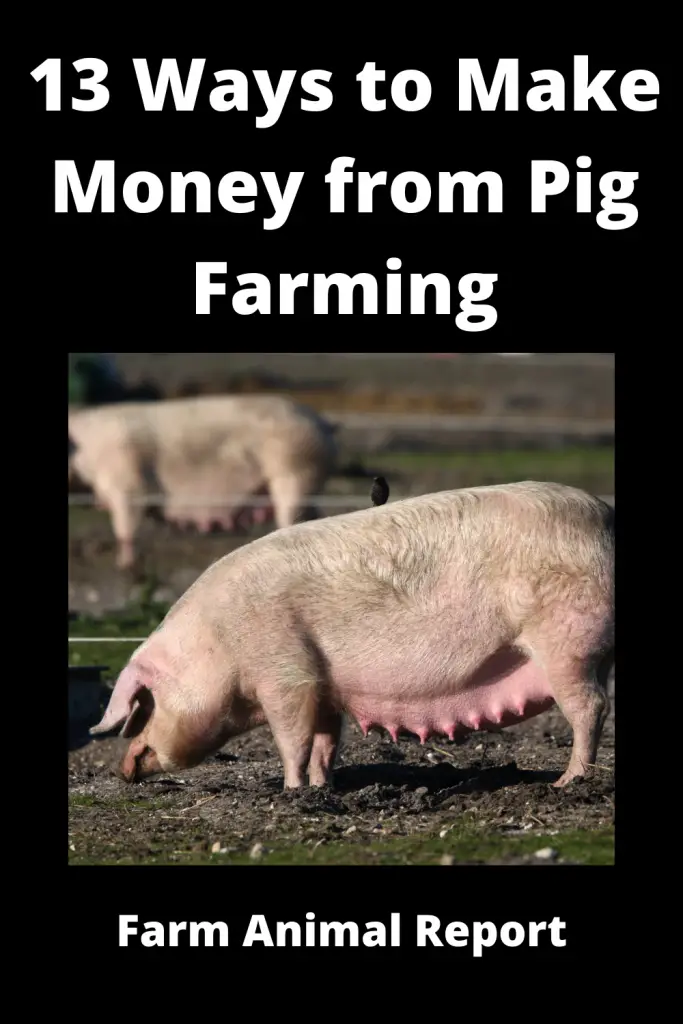
How much Profit can you Make Raising Pigs?
It is important to note that the profitability of pig farming varies depending on how and in what form you intend to sell the pork produced. If you farm one pig in the United States, you can expect to make a net profit of between $100 and $500 after half a year of farming, depending on how you sell the pig’s flesh (whether you will process its Meat or no and how you will feed it). Estimating feed costs, and how much pigs eat m is important when you own pigs.
A pound of pork is usually sold for between $ 2 and $ 4 per pound. The price per pound is usually around $ 3.5 on average. Market swine produce about 55 percent (+/- 10 percent) of the Meat after butchering and processing. Pigs can have as little as 40% flesh in their carcasses in the worst circumstances. As a result, with an average pig weighing approximately 265 pounds, the yield will be about 146 pounds of Meat. As a result, moderate pig flesh without processing will be valued at roughly $511.
Different Ways to Make Money from Pig Farming
Besides selling pork, a pig farm can generate income in various ways (raw, frozen, or processed). Pig farmers can also profit from the sale of newborn piglets and pig manure, which is used for fertilizing crops in the field. It is exclusively up to you which of these items you will use as your primary source of income; however, you will most likely be able to generate money from both at the same time. However, Meat is unquestionably the most important source of income, which is why we shall concentrate on it here. Pig meat that is converted into sausages and other products also worth significantly more.
How Much Money does a Pig Sell for?
As previously stated, market pigs sell for between $2.00 and $4.00 per pound, with an average price of $3.50 per pound. Pork is the most expensive Meat on the market. As a result, if you sell an 80-pound piglet, you will receive approximately $280.
How do you make Money Buying and Selling Pigs?
You make money by purchasing pigs from a respectable breeder, raising them with adequate care and supervision, and then selling them once they have reached the appropriate size. The marketing plan is the one thing that doesn’t make sense. Consequently, you must be aware of price changes in pigs and the existence of reliable breeders.
How many Pigs can you Raise per Acre?
You can raise almost 25-35 pigs per acre of land. We go with the lesser figure of 25 per acre to be on the safe side and give them plenty of areas to spread their roots. This suggests that you can raise 8-9 pigs on a 14-acre plot of land. In some cases, a single pig can be reared on a plot of land as tiny as 34′ x 34′. I believe that it is preferable to raise two pigs together rather than one pig at a time. Pigs are happier and more straightforward to deal with when a companion accompanies them. They are also less inclined to attempt to flee as a result of this.
What are the Best Pig Breeds to raise for Meat?
The top pig meat breeds are:
- Yorkshire
- Duroc
- Berkshire
- Landrace
- Meishan
- Chester White
- Hampshire
- Pietrain
- Hereford
- Tamworth
Can you Raise a Pig on 1 acre?
Yes, you may raise pigs on one acre of land, as previously stated. The stocking rate is known as the number of pigs per acre of land. The overall stocking rate for pigs per acre should be between 3,000 and 6,000 pounds per acre.
Why are pigs in a pound and not pigs in a pen? Because pigs are available in multiple sizes. According to the USDA, ten feeder pigs weighing 65 pounds have the same impact on the soil as one sow weighing 650 pounds.
On the low end, that equates to 50 feeder piglets or only five mature sows per acre of land. You may keep as many as 100 feeders or ten sows per acre on the top end of the scale.
Stock density is another crucial aspect to consider while farming pastured pigs, feed costs from pasture. The total number of pigs/boars per acre over time is referred to as the stocking rate. In the pig industry, stock density refers to the number of pigs present in a given region at a given time.
Maintaining the pigs on smaller units of the overall space allows you to distribute the pigs’ impact on the overall area more fairly.
In any particular region of the pasture, rooting and wallowing damage will be less severe than in another. The manure is distributed more uniformly, and the best forage plants have more time to recover and re-grow.
New producers should strive for a stocking density of approximately 20,000 pounds per acre when starting. For feeding pigs, that equates to about 130 square feet per pig. In a rotational system, grown sows require around 1,300 square feet per pig.
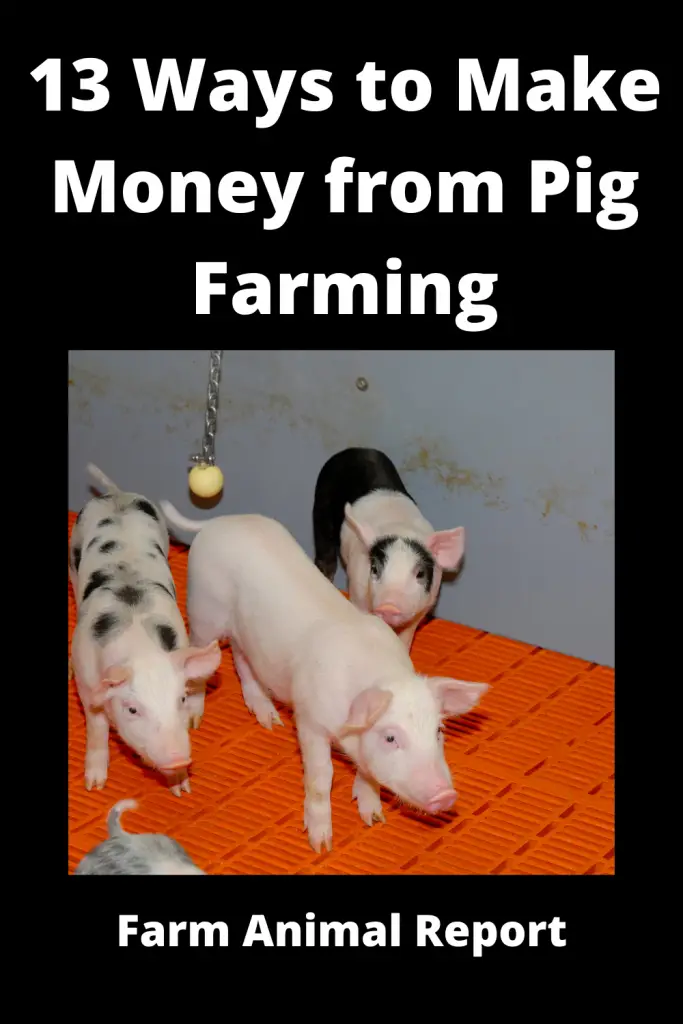
How Many Pigs can you Put on 100 acres?
On average, you can raise 3000 adult pigs in 100 acres.
Can You Free-Range Pigs?
Yes, you can free-range pigs in the same way that you would any other livestock animal. A free-range pig farming is one in which the pig herd is rotated on meadows or cropland rather than kept in a barn (e.g., sows are mated and farrow in paddocks, piglets are weaned and grown out in paddocks). On some farms, the production system is modified somehow (e.g., growers may be finished in shelters).
Free-range pigs are often kept in groups based on their age, gender, size, and stage of pregnancy, among other factors. They obtain most of their nutritional requirements from prepared feed, with pasture or forage serving as a supplementary source of nourishment. “Unrestricted-range” means that the animals are not kept in enclosures; they may be fed in a shed, but they typically have free access to pastures and other open areas of land. In most cases, specialty markets for pig meat products are sought.
Swine Products – Hams – Pigs Feet – Ribs etc
1. PORK BELLIES
The belly of a pig is a fatty and boneless piece of Meat that is commonly served. Pork belly is utilized in a variety of Asian recipes and in the production of bacon. Bellies are often chopped into thick, lengthy pieces and flash-frozen to preserve their shape. They are often highly sought-after cuts since they can be stored in a frozen state for an extended period of time and are even traded on the open market.
2. FRESH HAM
Ham is the rear leg of a pig that has not been cured. The hind leg of the pig is a single piece of meat that can be eaten whole. Ham can be left salty if it is uncured, or it can be cured, dried, and smoked to impart specific flavors to the finished product. On the other hand, our fresh ham is uncured, and no sugar is added at any point during the production process.
3. PORK LOIN
It is a beautiful cut that runs along the top of the pig’s ribcage, and it is known as the pig’s loin. Pork chops or bacon can be made from this cut of Meat.
4. PORK RIB
The cut of pork ribs can range from spare ribs to baby back ribs in terms of size and shape. Each cut has its own distinct texture and flavor.
5. PORK SHOULDER
The Butt or a Picnic Ham is the upper portion of a hog’s shoulder and front leg cut, depending on where the cut is made in the shoulder and front leg. This cut is trendy in the southern United States because it contains substantial meat and flavor.
6. PORK CHOPS
Traditionally, pork chops have been ribbed loin cuts, and they are the pork equivalent of beef rib eyes. Because the pork belly meat is usually left attached to the thick center cut chops, the pork belly meat is exceptionally flavorful.
- PIGS FEET
These are also edible and loved by many people.
Pig Manure
Farmers in the olden days would dig pig manure into their soil in the fall and allow it to decompose, releasing nutrients for the following spring’s crops. There is a problem with this today because an excessive number of pigs excrete E.coli, parasitic worms, salmonella, and a host of other pathogens in their manure. The question is, what should you do if you have a ready supply of pig manure and a garden that needs to be fed? Composting!
Best Types Pig Breeds
Best Pig Breeds for Pig Farming are:
1. Large White
This breed is all white, yet they have freckles on their faces (black pigment spots). A Large White pig has a reasonably large head, a slightly dished face, and a broad snout, all of which contribute to its name. It has a lovely, long neck that is evenly full to the shoulders, and it has deep and broad chests. Furthermore, they feature a long, level, and wide back. Mature boars weigh between 300 kg and 450 kg, and mature sows weigh between 250 kg and 350 kg, depending on their size. The carcass quality of large White pigs is excellent. The breed is highly productive and has a high feed utilization rate.
2. Landrace
This breed is likewise white with freckles, like the previous one. It is noted for having a long, deep side, relatively short legs, square ham, big lop ears, and a trim jowl, among other characteristics. Because of this, it has a slimmer carcass than Meat and less backfat and lard. The Landrace breed is highly productive and efficient in its use of feed. A mature male can weigh up to 380 kg, and a mature sow can weigh up to 320 kg, depending on the breed.
3. Duroc
Generally speaking, the breed’s color is significantly red, with hues ranging from golden to cherry red. The Duroc pig is well-known for having an excellent weight gain rate as well as a high feed conversion rate, among other characteristics. Because of her early maturity and huge litter size (up to 15 piglets), the sow has excellent mothering abilities. This pig breed’s mature boar and sow have good carcass quality and body weight of approximately 400 kg and 350 kg, respectively, for the mature boar and sow.
4. Poland China
Poland China pig is a black animal with white patches on its cheeks, paws, and snout, which gives it its name. It has a huge body and floppy ears on its head. It has strong bones, as well as well-developed legs and feet, among other characteristics. It is highly productive (producing 16 to 17 piglets per farrow) and produces Meat and carcass of outstanding quality. It is also known as an excellent converter of feed to Meat, and it reaches maturity at a relatively young age. A mature pig weighs between 260 kg and 360 kg, and a mature sow weighs between 235 kg and 310 kg (depending on the breed and location).
Transportation – Hauling Stock
Critical requirements for transporting pigs:
- Pigs are bright, curious animals that should be handled calmly and carefully by a knowledgeable livestock handler who has previous experience with pigs. It is not permissible to beat or prod any animals regularly!
- Pig transportation should be carried out to reduce stress, pain, and suffering for the animals involved. Livestock chosen for transport should be in good health and good condition.
- Pigs should permanently be moved with the assistance of a stock board (pictured above).
- Pigs showing signs of stress, such as collapse, panting or shaking, should be given ample opportunity to rest and calm before being transported or transferred.
- Pigs are unable to sweat, which is necessary for maintaining a stable body temperature. Pigs’ health can be jeopardized when they are transported in hot and humid environments.
- To minimize disease transmission, vehicles used for transporting pigs must be designed from materials that allow for thorough cleaning.
- Floors should have a non-slip surface that is not harmful to the hooves or legs of animals. Due to the sensitive skin of pigs, transport vehicles must be covered in order to give protection.
Contact your livestock hauler or broker if you require assistance in arranging transportation for your pigs.
Custom Feeds for pigs
You can make custom pig feed by following this procedure:
Feed a sorghum-based diet with 10% soybean meal, 7% calcium and protein supplement, 4% sunflower or peanut meal, and 0.25 percent salt.
Feed your breeder pigs a different mix than the rest of your pigs to ensure a successful breeding program. Preparation of a feed mix including 80 percent sorghum, 10 percent sunflower meal, 10 percent calcium and protein supplement, and 0.25 percent sodium chloride.
Stud Fees
Stud fees vary depending on the length of time a male animal is kept in captivity. They also differ from country to country. However, stud fees are often between 100 and 200 $. Farmers, on the other hand, are increasingly turning to artificial insemination. The cost to inseminate a pig (A.I.) varies from $20 to $250 per dosage. Each pig requires two dosages, resulting in a total cost of $40-500 per pig in semen. As you can see, the cost of sperm varies significantly. Typically, the high price shows that pig-producing boars are the greater production type boars, while the lower dollar shows pig producing boars are the lower cost per dosage.
What size is the Average Family Hog Farm?
The average family hog farm is about 2,100 square feet. This includes the living quarters for the pigs, the pens, and the farrowing area. The average farm has between four and six pigs. The sows are usually kept in separate pens from the boars and other male pigs.
The reason for this is to prevent fighting and aggression. Farrowing is the process of giving birth to piglets. A sow will have a litter of between six and twelve piglets. The gestation period for a sow is three months, three weeks, and three days.
On average, a hog will live for six years. However, commercial farms often butcher hogs before they reach this age. Family hog farms typically sell their pork directly to consumers or to local restaurants and butcher shops.
How many Piglets will a Mother Pig Average in a Litter?
A mother pig will usually give birth to between six and twelve piglets in a litter. However, there can be more or fewer piglets born depending on the breed of pig. Some pigs can have as many as eighteen piglets in a litter.
The average litter size for a domestic pig is around ten, but this number can vary greatly. Litters of six or seven are not uncommon, and some pigs may only have two or three piglets. In general, the larger the breed of pig, the larger the litter size will be. So, while a miniature pig might only have four or five piglets in a litter, a large sow could have fifteen or more.
When can Male Pigs be Ready to Breed?
Male pigs can be ready to breed as early as four months old, although six to eight months old is more common. Sires used for artificial insemination is often selected based on their block genes, which produce offspring with superior muscling and leanness. The age at which a male pig reaches puberty is influenced by many factors, including nutrition and genetics.
Good nutrition is essential for genital development and semen production. For example, boars fed a high-protein diet tend to reach puberty at an earlier age than those fed a lower-protein diet. Genetics also plays a role in when a male pig will reach puberty; certain breeds tend to mature faster than others.
However, it is important to note that body size is not always an accurate indicator of reproductive maturity. Some small breeds may be fully mature by four months old, while some large breeds may not reach puberty until they are eight or nine months old. Ultimately, the best way to determine when a male pig is ready to breed is to have him examined by a veterinarian or qualified animal reproductive specialist
What is a Factory Pig farm?
A factory pig farm is an intensive livestock operation that raises large numbers of pigs in a confined space. These farms are typically operated as commercial ventures, with the animals being raised for their meat.
Due to the high density of animals, factory pig farms must take special measures to prevent the spread of disease. This typically involves providing clean water and food, as well as maintaining a clean and spacious environment.
In addition, factory pigs are usually given routine vaccinations to help protect them from common illnesses. Although factory pig farms can be controversial, they play an important role in the global food supply
What Type of Production system supports a Pig farm?
A typical pig farm has several production systems that support the piggery. These include sow stall systems, farrowing crates, outdoor systems, and pen systems. Sow stall systems confine the sow during pregnancy and farrowing.
The sow is typically moved to a farrowing crate where she gives birth and nurses her piglets. Outdoor systems are used to raise pigs that are typically older and have already been weaned from their mothers.
Pen systems are used to raise pigs of all ages and sizes. The type of production system used on a pig farm depends on the size of the operation and the preference of the farmer.
Final Thoughts
Choosing which pigs to purchase, whether buying breeding stock or younger feeder pigs, can significantly impact your enterprise’s profitability. Investing in healthy, high-quality pigs is an excellent place to begin!


